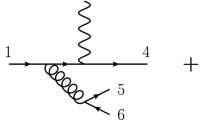Abstract
We discuss the dispersive representation of the D-term form factor for hard exclusive reactions, using unsubtracted t-channel dispersion relations. This representation provides a microscopical interpretation of the physical content of the D-term form factor in terms of t-channel exchanges with the appropriate quantum numbers. The contribution from two-pion intermediate states is explicitly evaluated, and the corresponding results for the D-term form factor as function of t as well as at t = 0 are discussed in comparison with available model predictions and phenomenological parametrizations.
Similar content being viewed by others
References
Drechsel D., Pasquini B., Vanderhaeghen M.: Dispersion relations in real and virtual compton scattering. Phys. Rep. 378, 99 (2003)
Pasquini B., Gorchtein M., Drechsel D., Metz A., Vanderhaeghen M.: Dispersion relation formalism for virtual compton scattering off the proton. Eur. Phys. J. A. 11, 185 (2001)
Pasquini B., Gorchtein M., Drechsel D., Metz A., Vanderhaeghen M.: Dispersion relation formalism for virtual compton scattering and the generalized polarizabilities of the nucleon. Phys. Rev. C 62, 052201 (2000)
Drechsel D., Gorchtein M., Pasquini B., Vanderhaeghen M.: Fixed-t subtracted dispersion relations for compton scattering off the nucleon. Phys. Rev. C 61, 015204 (1999)
Pasquini B., Drechsel D., Vanderhaeghen M.: Proton spin polarizabilities from polarized compton scattering. Phys. Rev. C 76, 015203 (2007)
Pasquini B., Drechsel D., Scherer S.: The polarizability of the pion: no conflict between dispersion theory and chiral perturbation theory. Phys. Rev. C 77, 065211 (2008)
Anikin I.V., Teryaev O.V.: Dispersion relations and subtractions in hard exclusive processes. Phys. Rev. D 76, 056007 (2007)
Teryaev, O.V.:Analytic properties of hard exclusive amplitudes. hep-ph/0510031
Radyushkin A.V.: Generalized parton distributions and their singularities. Phys. Rev. D 83, 076006 (2011)
Goldstein G.R., Liuti S.: The use of dispersion relations in hard exclusive processes and the partonic interpretation of deeply virtual compton scattering. Phys. Rev. D 80, 071501 (2009)
Polyakov M.V., Weiss C.: Skewed and double distributions in pion and nucleon. Phys. Rev. D 60, 114017 (1999)
Guidal M., Moutarde H., Vanderhaeghen M.: Generalized parton distributions in the valence region from deeply virtual compton scattering. Rep. Prog. Phys. 76, 066202 (2013)
Kumericki K., Mueller D., Passek-Kumericki K.: Towards a fitting procedure for deeply virtual compton scattering at next-to-leading order and beyond. Nucl. Phys. B 794, 244 (2008)
Goldstein G.R., Hernandez J.O., Liuti S.: Flexible parametrization of generalized parton distributions from deeply virtual compton scattering observables. Phys. Rev. D 84, 034007 (2011)
Gonzalez-Hernandez J.O., Liuti S., Goldstein G.R., Kathuria K.: Interpretation of the flavor dependence of nucleon form factors in a generalized parton distribution model. Phys. Rev. C 88, 065206 (2013)
Pasquini, B., Polyakov, M.V., Vanderhaeghen, M.: Dispersive evaluation of the D-term form factor in deeply virtual compton scattering. Phys. Lett. B 739, 133 (2014)
Diehl M., Ivanov D.Y.: Dispersion representations for hard exclusive processes. Eur. Phys. J. C 52, 919 (2007)
Frazer W.R., Fulco J.R.: Partial-wave dispersion relations for the process \({\pi\pi\rightarrow N\bar{N}}\) . Phys. Rev. 117, 1603 (1960)
Diehl M., Gousset T., Pire B., Teryaev O.: Probing partonic structure in \({\gamma^{*} \gamma\rightarrow\pi\pi}\) near threshold. Phys. Rev. Lett. 81, 1782 (1998)
Diehl M., Gousset T., Pire B.: A Monte-Carlo for exclusive production of pion pairs in \({\gamma^{*} \gamma}\) collisions at large Q2. Phys. Rev. D 62, 073014 (2000)
Polyakov M.V.: Hard exclusive electroproduction of two pions and their resonances. Nucl. Phys. B 555, 231 (1999)
Kivel N., Mankiewicz L., Polyakov M.V.: NLO corrections and contribution of a tensor gluon operator to the process \({\gamma^{*} \gamma\rightarrow\pi\pi}\) . Phys. Lett. B 467, 263 (1999)
Schopper, H. (ed.): Pion nucleon scattering. Part 2: methods and results of phenomenological analyses, Landolt-Börnstein, vol. 9b2. Springer, Berlin, Heidelberg (1983)
Froggatt C.D., Petersen J.L.: Phase shift analysis of \({\pi^{+} \pi^{-}}\) scattering between 1.0 GeV and 1.8 GeV based on fixed momentum transfer analyticity (II). Nucl. Phys. B 129, 89 (1977)
Lehmann-Dronke B., Pobylitsa P.V., Polyakov M.V., Schafer A., Goeke K.: Hard diffractive electroproduction of two pions. Phys. Lett. B 475, 147 (2000)
Lehmann-Dronke B., Schaefer A., Polyakov M.V., Goeke K.: Angular distributions in hard exclusive production of pion pairs. Phys. Rev. D 63, 114001 (2001)
Warkentin N., Diehl M., Ivanov D.Y., Schäfer A.: Exclusive electroproduction of pion pairs. Eur. Phys. J. A 32, 273 (2007)
Polyakov M.V., Weiss C.: Two-pion light-cone distribution amplitudes from the instanton vacuum. Phys. Rev. D 59, 091502 (1999)
Owens J.F.: Q2 dependent parametrizations of pion parton distribution functions. Phys. Rev. D 30, 943 (1984)
Gluck M., Reya E., Vogt A.: Pionic parton distributions. Z. Phys. C 53, 651 (1992)
Goeke K., Grabis J., Ossmann J., Polyakov M.V., Schweitzer P., Silva A., Urbano D.: Nucleon form-factors of the energy momentum tensor in the chiral quark-soliton mode. Phys. Rev. D 75, 094021 (2007)
Goeke K., Grabis J., Ossmann J., Schweitzer P., Silva A., Urbano D.: The pion mass dependence of the nucleon form-factors of the energy momentum tensor in the chiral quark-soliton model. Phys. Rev. C 75, 055207 (2007)
Cebulla C., Goeke K., Ossmann J., Schweitzer P.: The nucleon form-factors of the energy momentum tensor in the Skyrme model. Nucl. Phys. A 794, 87 (2007)
Mueller, D., Hwang, D.S.: GPD and PDF modeling in terms of effective light-cone wave functions. arXiv:1108.3869[hep-ph]
Polyakov M.V.: Generalized parton distributions and strong forces inside nucleons and nuclei. Phys. Lett. B 555, 57 (2003)
Polyakov, M.V., Shuvaev, A.G.: On ‘dual’ parametrizations of generalized parton distributions. hep-ph/0207153
Author information
Authors and Affiliations
Corresponding author
Rights and permissions
About this article
Cite this article
Pasquini, B. Dispersion Representation of Deeply Virtual Compton Scattering. Few-Body Syst 56, 267–273 (2015). https://doi.org/10.1007/s00601-015-0954-3
Received:
Accepted:
Published:
Issue Date:
DOI: https://doi.org/10.1007/s00601-015-0954-3



